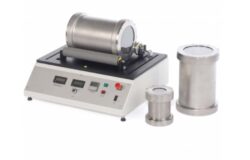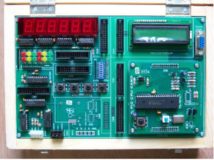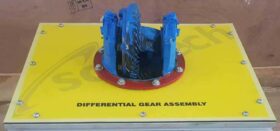Demineralization Water Treatment Plant Model ENV 017
Home » Products » Demineralization Water Treatment Plant Model ENV 017
Demineralization Water Treatment Plant Model ENV 017
Sci-tech Water Treatment Plant Model ENV 017 carries out water purification. Ion-exchange is a rapid and reversible process in which impurity ions present in the water are replaced by ions released by an ion-exchange resin. The impurity ions are taken up by the resin, which must be periodically regenerated to restore it to the original ionic form. (An ion is an atom or group of atoms with an electric charge. Positively-charged ions are called cations and are usually metals; negatively-charged ions are called anions and are usually non-metals).
Raw Water is passed via two small polystyrene bead filled (ion exchange resins) beds. While the cations get exchanged with hydrogen ions in first bed, the anions are exchanged with hydroxyl ions, in the second one.
Demineralization is the process of removing mineral salts from Water by using the ion exchange process.
Demineralized Water is Water almost completely free of dissolved minerals as a result of one of the following processes :
- Distillation
- Deionization
- Membrane filtration (reverse osmosis or nano-filtration)
- Electro-dyalisis
| Size: | 140cm x 80cm x 120cm (LxWxH) |
| Weight: | 120 kg |
Item Description
Demineralization is the process of removing mineral salts from Water by using the ion exchange process.
Demineralized Water is Water almost completely free of dissolved minerals as a result of one of the following processes :
- Distillation
- Deionization
- Membrane filtration (reverse osmosis or nano-filtration)
- Electro-dyalisis
Demineralized Water also known as Deionized Water, Water that has had its mineral ions removed. Mineral ions such as cations of sodium, calcium, iron, copper, etc and anions such as chloride, sulphate, nitrate, etc are common ions present in Water. Deionization is a physical process which uses specially-manufactured ion exchange resins which provides ion exchange site for the replacement of the mineral salts in Water with Water forming H+ and OH- ions. Because the majority of Water impurities are dissolved salts, deionization produces a high purity Water that is generally similar to distilled Water, and this process is quick and without scale buildup. De-mineralization technology is the proven process for treatment of Water. A DM Water System produces mineral free Water by operating on the principles of ion exchange, Degasification, and polishing. Demineralized Water System finds wide application in the field of steam, power, process, and cooling.
Sci-tech Water Treatment Plant Model ENV 017 carries out water purification. Ion-exchange is a rapid and reversible process in which impurity ions present in the water are replaced by ions released by an ion-exchange resin. The impurity ions are taken up by the resin, which must be periodically regenerated to restore it to the original ionic form. (An ion is an atom or group of atoms with an electric charge. Positively-charged ions are called cations and are usually metals; negatively-charged ions are called anions and are usually non-metals).
Raw Water is passed via two small polystyrene bead filled (ion exchange resins) beds. While the cations get exchanged with hydrogen ions in first bed, the anions are exchanged with hydroxyl ions, in the second one.
The following ions are widely found in raw Waters:
Cations
- Calcium (Ca2+)
- Magnesium (Mg2+)
- Sodium (Na+)
- Potassium (K+)
Anions
- Chloride (Cl-)
- Bicarbonate (HCO3-)
- Nitrate (NO3-)
- Carbonate (CO32-)
Ion Exchange Resins
There are two basic types of resin – cation-exchange and anion-exchange resins. Cation exchange resins will release Hydrogen (H+) ions or other positively charged ions in exchange for impurity cations present in the Water. Anion exchange resins will release hydroxyl (OH-) ions or other negatively charged ions in exchange for impurity anions present in the Water.
The application of ion-exchange to Water treatment and purification. There are three ways in which ion-exchange technology can be used in Water treatment and purification: first, cation-exchange resins alone can be employed to soften Water by base exchange; secondly, anion-exchange resins alone can be used for organic scavenging or nitrate removal; and thirdly, combinations of cation-exchange and anion-exchange resins can be used to remove virtually all the ionic impurities present in the feedWater, a process known as deionization. Water deionizers purification process results in Water of exceptionally high quality.
Deionization
For many laboratory and industrial applications, high-purity Water which is essentially free from ionic contaminants is required. Water of this quality can be produced by deionization. The two most common types of deionization are :
- Two-bed deionization
- Mixed-bed deionization
Two-bed deionization
The two-bed deionizer consists of two vessels – one containing a cation-exchange resin in the hydrogen (H+) form and the other containing an anion resin in the hydroxyl (OH-) form. Water flows through the cation column, whereupon all the cations are exchanged for hydrogen ions. To keep the Water electrically balanced, for every monovalent cation, e.g. Na+, one hydrogen ion is exchanged and for every divalent cation, e.g. Ca2+, or Mg2+, two hydrogen ions are exchanged. The same principle applies when considering anion-exchange. The decationised Water then flows through the anion column. This time, all the negatively charged ions are exchanged for hydroxide ions which then combine with the hydrogen ions to form Water (H2O).
Mixed-bed deionization
In mixed-bed deionizers the cation-exchange and anion-exchange resins are intimately mixed and contained in a single pressure vessel. The thorough mixture of cation-exchangers and anion-exchangers in a single column makes a mixed-bed deionizer equivalent to a lengthy series of two-bed plants. As a result, the Water quality obtained from a mixed-bed deionizer is appreciably higher than that produced by a two-bed plant. Although more efficient in purifying the incoming feedWater, mixed-bed plants are more sensitive to impurities in the Water supply and involve a more complicated regeneration process. Mixed-bed deionizers are normally used to ‘polish’ the Water to higher levels of purity after it has been initially treated by either a two-bed deionizer or a reverse osmosis unit.
Electrodeionization EDI
Electrodeionization Systems remove ions from aqueous streams, typically in conjunction with reverse osmosis (RO) and other purification devices. Our high-quality deionization modules continually produce ultrapure Water up to 18.2MW/cm. EDI may be run continuously or intermittently
Advantages
- Variety of cost effective standard models.
- Improved aesthetics and rugged design.
- User friendly, low maintenance and easy to install.
- Simpler distribution and collection systems.
- Quick availability.
- Pre dispatch assembly check.
- The multiport valves are top mounted as well as side mounted with the necessary high pressure rating PVC piping.
- Single valve operation as compared to the six valves in conventional filters
- Each operating step is clearly marked on the valve, thereby eliminating chances of error in the operating sequence.
- Single valve assembly, with its simplified frontal Piping, simpler distribution collecting systems is Very easy to install.
- Rust free
- Less power consumption
- Durable
- Economical
- High shelf life
Major Applications
- Boilers feed Water, Textiles, Pharmaceuticals, Chemicals, Breweries, Swimming pools, Potable Water, Hospitals, Automobile, and Battery, Fertilizers.
- Ion Exchange Plants
– Softener
– Industrial DM Plant
– Two Stage & Multi Stage DM Plants
– Mix Bed Demineraliser
– De-Gasifiers
– Cation Polisher
– Manual/Automatic Plants
– Pharmaceutical Industry
– Power Plant
– Oil & Gas sector
– Chemical Industries
– Textile Industries
Portable or Mini- DM Water Treatment Plant
The Water free from any mineral is called De- Mineralised Water (D.M.Water). Naturally occurring Water has various salts in dilute form which are called dissolved solids (TDS). When the Water having such mineral is required to be free from this, it is to be treated in Ion Exchange Resins column (H form) which adsorbs the positively charge ion. Now the cations free passed through Anion Resin Column (OH form) which adsorbs the negatively charged anions and Water free from the total ions shall comes out from the system.
Technical Specifications
Technical data
- Flow rate: 30 to 50 Lit / hr.
- Space requirement: very compact- 1 m x 1m
- Power: NIL, Min inlet pressure 0.5 kg/cm2
- Output TDS: Less that 10 ppm
- Output DM Qty: 200 Lit at 100 ppm TDS
- (Best suitable when feed Water is corporation Water TDS < 100 ppm)
- Vessels MOC: FRP
- Pump: Horizontal, Centrifugal
- Skid: MS Powder coated
- ‘Sci-Cal’ Computer Control Software & Interface
‘Sci-Cal’ software & hardware has been designed for use with more than 600 ‘Sci-tech’ trainers. ‘Sci-Cal’ comes in a module that can be fitted or mounted on the Sci-tech trainers very easily.
‘Sci-Cal’ box has 11 inches front HMI interactive panel, inside are i3 processor computer with it’s own hard drive & software processor with 16 to 32 analog and 16 to 32 digital signal data-loggers. The ‘LabVIEW’ processes the input signal with in-built data and formulae to tabulate results for the Sci-tech trainers.
‘Sci-Cal’ box has HDMI output for connection to a projector or an electronic whiteboard or a monitor.
‘Sci-Cal’ box has input ports for inputs from the Sci-tech trainer sensors.
‘Sci-Cal’ eliminates requirement of external computer.
On Site Requirements:
- Three Phase 400~440V @ 50 Hz & Single Phase 230V @ 50Hz Power Supply
- Hand Tools for fitting and re-fitting of parts.
- Water Source
Model Number
ENV 017
See also different:

Features Comminution with a ball mill Observation of the milling process Ball mills are a form of mills with grinding bodies. The drums can be opened at the front and loaded with the material to be milled (limestone is recommended) and the mil [...]



